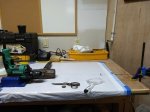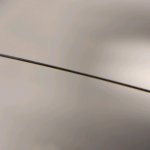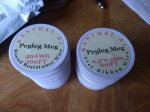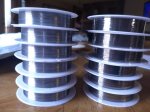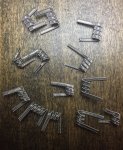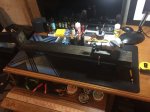so in the 'post your builds' thread, there is a ton of good information, questions and answers on everything from basic, to highly advanced builds and techniques. its quickly grown into an amazing resource, but its also quickly grown too large to find that info in. most of us have answered the same questions over and over again.
the idea for these 'the official x thread', is to get the information on 'x' (build/technique) all in one place so its easier to find, and consolidate the questions/answers/discussion a little bit, and leave that other thread for pics, chat and encouragement. links to all the 'official' threads are collected here, have a look through the rest for tips on everything from planning a build in steam-engine, beginner to advanced builds, and even coil photography. this is the official stagger/fuse thread. feel free to ask questions, post tips or tricks or anything related.
info: staggered fuse is a hard technique where you employ spaced clapton wraps using one of a few tricks we will discuss below, and a second pass of fuse wrap to combine two different elements/ingredients into one. the most basic example is the staggered fused clapton. it consists of two strands of spaced clapton wire, which are fused together during a second pass of claptoning in between the first spaced wraps. at its most advanced, the second pass is 'skip fused' into every second, third, fourth space, and 2nd, 3rd and 4th passes of fuse will add on different layers, or even staggering alien wraps in between spaced alien wraps. this technique is the foundation of many complex builds, so its an essential imo.
there are two parts to complete this technique, the spacing and the fusing. lets cover some of the spacing methods for round and square/rectangular elements. most of these use a second piece of wire to create the space in between the clapton wraps, and are mostly just variations on a way to hold it in place. the only one that doesnt use a wire is hand spacing. spacing by hand is hard to get consistent, but for some builds, it seems to be the best way (alien staggs).
the loop trick:
-this works best on round wire, and ok on perfectly square ribbon stacks (4 x .4mm or 3 x .3mm etc)
-pre-cut a piece of whatever gauge wrap wire you plan to use long enough to make the right sized loop out of (the right size being whatever works for you)
-start a clapton, but hold the spool ahead enough that the wraps dont touch
-do about an inch, then lock your wrap wire into the spool and set it down
-take your pre-cut wire and throw it over your clapton wraps and tie/twist the ends together so they make a loop
-set the loop right behind your wrap wire and hold the loop right beside the wrap wire, however you normally hold it when you are claptoning, and pull tension on the loop until its not slack
-tension is key here. if the wrap wire, or loop, are not equally tight, they will skip over eachother or make bad spacing
-too tight and you get all the other problems tension brings to the party
-hold a 90 degree angle to your cores so your spaced clapton wraps are nice and straight/vertical
-once you get tension and good spacing dialed in go fast and get it over with


the weighted loop:
-this is the same as the loop trick, but with a weight holding the loop down
-make sure you cut your loop wire so its able to hang free. likely a bit shorter than you would for a finger loop. this depends on the height of your drill/swivels
-common practice is to use an atomizer, so set up the loop like before, but take the drip tip off a goon or something, stick the end of the loop in the hole, and put the tip back in to pinch it in
-a trick i saw n.devine use is to also use one of those drawstring clamps that are on hoodies and jackets to stabilize the loop in between the atty thats hanging off it and the spinning core wire you are wrapping up. it works great btw
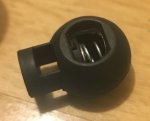

once you get the clamp and atty on the loop, slide the clamp up close to the top and the weight will be very stable compared to without. if you cant find one of these things on a jacket or hoodie, try tape or anything else to cinch the loop up close to the top.

the button trick:
-this is another way to hold the loop of wire
-this method is not for square stacks
-start a half inch or so of hand spaced clapton
-put your pre-cut piece of wire over the wraps like before, but this time stick both ends of the wire through a button, hold it tight and make sure your loop is right next to your wrap wire, then tie it in a tight knot
-cut a long enough piece of wire that its easy to tie the loop through the button and cut off the excess or just pull it out of the way so it doesnt tangle up in your work
-if its not tight enough, angle the button so the loop side (not the knot side) is facing you, and rotate the button 180 degrees. you should feel it get tight and kinda click into place
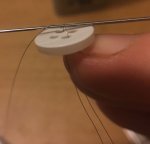
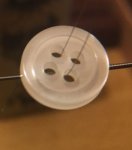
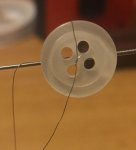
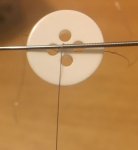
para-clapton
-this method requires a second spool of wire (or anything the proper gauge) to be wrapped onto your core wire in parallel with no spaces
-once you get to the end of the core wire, you unwrap the spacing wire (or whatever you used. ill use fishing line thats 38 gauge in the pics)
-this method is best for non-round things like ribbon stacks, but can be used to get tight, perfect spacing on anything
-its a waste of wire or whatever you use to parallel wrap with, but its one of the best ways to get perfect spacing
-there are a few ways to do this, but i like the zip-lock bag method
-take your two spools and put them in sandwich bags that have the zipper style top
-pull a couple inches of wire out of the bag, and close the zipper thing so its only opened and inch or two (with the wire poking out of the opening)
-set the bags on your lap, or on the floor by your feet, or on either side of your body/chair, or wherever you like them best. they can get a little tangled up in there and lift off your lap/the floor/poltergeist shit, but so far for me, they always end up just falling back down without getting in the way
-the key here is to hold your two wires tight together so they wrap in perfect parallel onto your core(s)
-when you are at the end of your core wire, fasten down your wrap wire and reverse your spacing wire off to reveal your perfect spacing
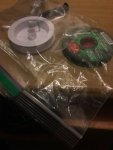
i hit the picture limit, continued in next post
the idea for these 'the official x thread', is to get the information on 'x' (build/technique) all in one place so its easier to find, and consolidate the questions/answers/discussion a little bit, and leave that other thread for pics, chat and encouragement. links to all the 'official' threads are collected here, have a look through the rest for tips on everything from planning a build in steam-engine, beginner to advanced builds, and even coil photography. this is the official stagger/fuse thread. feel free to ask questions, post tips or tricks or anything related.
info: staggered fuse is a hard technique where you employ spaced clapton wraps using one of a few tricks we will discuss below, and a second pass of fuse wrap to combine two different elements/ingredients into one. the most basic example is the staggered fused clapton. it consists of two strands of spaced clapton wire, which are fused together during a second pass of claptoning in between the first spaced wraps. at its most advanced, the second pass is 'skip fused' into every second, third, fourth space, and 2nd, 3rd and 4th passes of fuse will add on different layers, or even staggering alien wraps in between spaced alien wraps. this technique is the foundation of many complex builds, so its an essential imo.
there are two parts to complete this technique, the spacing and the fusing. lets cover some of the spacing methods for round and square/rectangular elements. most of these use a second piece of wire to create the space in between the clapton wraps, and are mostly just variations on a way to hold it in place. the only one that doesnt use a wire is hand spacing. spacing by hand is hard to get consistent, but for some builds, it seems to be the best way (alien staggs).
the loop trick:
-this works best on round wire, and ok on perfectly square ribbon stacks (4 x .4mm or 3 x .3mm etc)
-pre-cut a piece of whatever gauge wrap wire you plan to use long enough to make the right sized loop out of (the right size being whatever works for you)
-start a clapton, but hold the spool ahead enough that the wraps dont touch
-do about an inch, then lock your wrap wire into the spool and set it down
-take your pre-cut wire and throw it over your clapton wraps and tie/twist the ends together so they make a loop
-set the loop right behind your wrap wire and hold the loop right beside the wrap wire, however you normally hold it when you are claptoning, and pull tension on the loop until its not slack
-tension is key here. if the wrap wire, or loop, are not equally tight, they will skip over eachother or make bad spacing
-too tight and you get all the other problems tension brings to the party
-hold a 90 degree angle to your cores so your spaced clapton wraps are nice and straight/vertical
-once you get tension and good spacing dialed in go fast and get it over with


the weighted loop:
-this is the same as the loop trick, but with a weight holding the loop down
-make sure you cut your loop wire so its able to hang free. likely a bit shorter than you would for a finger loop. this depends on the height of your drill/swivels
-common practice is to use an atomizer, so set up the loop like before, but take the drip tip off a goon or something, stick the end of the loop in the hole, and put the tip back in to pinch it in
-a trick i saw n.devine use is to also use one of those drawstring clamps that are on hoodies and jackets to stabilize the loop in between the atty thats hanging off it and the spinning core wire you are wrapping up. it works great btw


once you get the clamp and atty on the loop, slide the clamp up close to the top and the weight will be very stable compared to without. if you cant find one of these things on a jacket or hoodie, try tape or anything else to cinch the loop up close to the top.

the button trick:
-this is another way to hold the loop of wire
-this method is not for square stacks
-start a half inch or so of hand spaced clapton
-put your pre-cut piece of wire over the wraps like before, but this time stick both ends of the wire through a button, hold it tight and make sure your loop is right next to your wrap wire, then tie it in a tight knot
-cut a long enough piece of wire that its easy to tie the loop through the button and cut off the excess or just pull it out of the way so it doesnt tangle up in your work
-if its not tight enough, angle the button so the loop side (not the knot side) is facing you, and rotate the button 180 degrees. you should feel it get tight and kinda click into place




para-clapton
-this method requires a second spool of wire (or anything the proper gauge) to be wrapped onto your core wire in parallel with no spaces
-once you get to the end of the core wire, you unwrap the spacing wire (or whatever you used. ill use fishing line thats 38 gauge in the pics)
-this method is best for non-round things like ribbon stacks, but can be used to get tight, perfect spacing on anything
-its a waste of wire or whatever you use to parallel wrap with, but its one of the best ways to get perfect spacing
-there are a few ways to do this, but i like the zip-lock bag method
-take your two spools and put them in sandwich bags that have the zipper style top
-pull a couple inches of wire out of the bag, and close the zipper thing so its only opened and inch or two (with the wire poking out of the opening)
-set the bags on your lap, or on the floor by your feet, or on either side of your body/chair, or wherever you like them best. they can get a little tangled up in there and lift off your lap/the floor/poltergeist shit, but so far for me, they always end up just falling back down without getting in the way
-the key here is to hold your two wires tight together so they wrap in perfect parallel onto your core(s)
-when you are at the end of your core wire, fasten down your wrap wire and reverse your spacing wire off to reveal your perfect spacing

i hit the picture limit, continued in next post
Last edited:

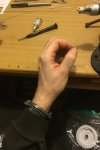
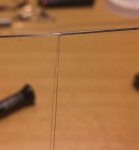
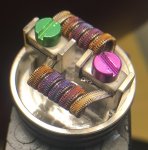
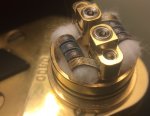
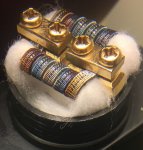

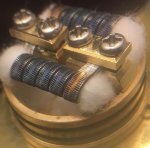
 thank you very much for taking the time to pull all this together
thank you very much for taking the time to pull all this together


